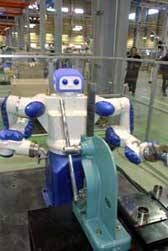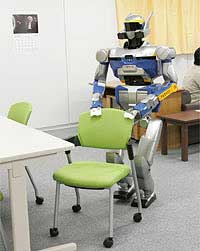Big thanks to Konomi who forwarded and translated for me a few robot news from Japan (as he did a few days ago for these robotic curiosities).
Yasukawa Denki has built a new robot factory in Kitakyushu (picture on the left). The factory, poised to become one of the largest in the world, can build about 2,000 robots a month and may be in full operation late 2007/ early 2008.
Via Yomiuri.

 AIST upgraded the HRP-2 Promete humanoid robot by integrating a new 3D vision system called Versatile Volumetric Vision (image on the right). A laser-based distance mesurement device is built into the head so that they can build a 2D map of the area while walking. The head scans right and left while the robot makes small movements. Four cameras are attached to the head, one for a panoramic view and the other for depth vision. The images are processed to recognize the shapes of objects like chairs, the refrigerator door handle and cans of juice. Moreover, HRP-2 Promete can hear better using microphone arrays that allow them to distinguish spoken commands from background noises.
AIST upgraded the HRP-2 Promete humanoid robot by integrating a new 3D vision system called Versatile Volumetric Vision (image on the right). A laser-based distance mesurement device is built into the head so that they can build a 2D map of the area while walking. The head scans right and left while the robot makes small movements. Four cameras are attached to the head, one for a panoramic view and the other for depth vision. The images are processed to recognize the shapes of objects like chairs, the refrigerator door handle and cans of juice. Moreover, HRP-2 Promete can hear better using microphone arrays that allow them to distinguish spoken commands from background noises.
The scientists also developed an interactive learning system allowing people to teach robots how to open a fridge and get something.
Experiments showed that when told to get a can of juice from the fridge the robot was able to negotiate its way to the kitchen, move a chair that was blocking the way, open the refrigerator, get the juice and bring it back to the other room and place it on a table near the person watching TV.
Via Nikkei. Also in Robot Gossips.
Shiga Medical College and Ritsumeikan University are now showing the outcome of their research on micro robts at Collabo 21 in the Japanese city of Ohtsu.
Their new capsule-shaped robots can go into human bodies for medical purposes. They measure about 2cmx2cm, and are therefore much smaller than the many-legged robot that crawls through intestines and other similar tiny robots developed elsewhere. The researchers’ goal is to finish implementing these robots by 2010.
Related: ragworm for “pleasurable” endoscopy.
